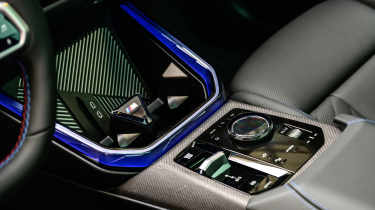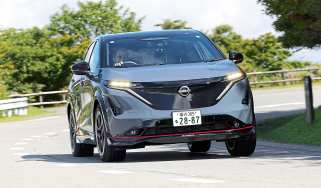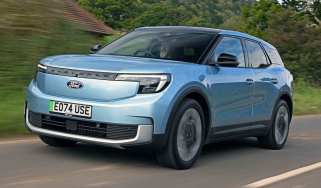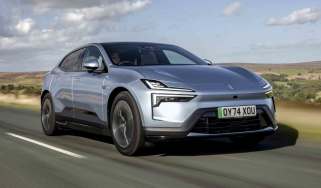BMW X3 - Interior, design & technology
Cutting-edge interior technology works well and is backed up by tremendous build quality. The exterior design might put some off, though.

BMW’s exterior design language has been pretty bold of late and the X3 is no exception to this. The proportions are typical X3, but the surfacing clearly takes some influence from the all-electric iX and the pronounced kidney grille, bluff front-end and pointed headlights give it a distinctive, imposing look. Compared to the rounded features of the old X3, the new one is much more crisp and certainly conveys its premium status.
The sides and rear of the X3 are a little softer. There’s a lot of smooth surfaces, and instead of giving the X3 off-road-style wheelarch extensions, BMW has opted for creases in the body to curve around the wheels, similar to the iX. At the back, there are large rear lights and a flush-fitting rear window; overall it’s a rather simple design.
LED lights are standard front and rear, but to really help the X3 stand out there’s an option to add BMW’s ‘iconic glow’ to the kidney grilles. The headlights can be specified with adaptive matrix high beams, and are also offered with a standard or ‘shadowline’ finish with blue internal elements.
The M Sport package isn’t just for the M50, as it’s offered on all powertrains. It adds 19-inch alloy wheels over the xLine’s 18-inch rims, a more aggressive front bumper with gloss black inserts and a larger lower intake, body-coloured side skirts and a different rear spoiler – again, with more gloss black on show. An M Sport package, Pro, builds on this by adding the illuminated grille and red brake calipers.
More reviews
Car group tests
- Land Rover Discovery Sport vs BMW X3 vs Volvo XC60
- BMW X3 vs Mercedes GLC
- BMW X3 M vs Alfa Romeo Stelvio Quadrifoglio
In-depth reviews
Road tests
Used car tests
BMW offers one solid shade and eight metallics for the new X3 – including a new ‘Dune Grey’ metallic finish. The one, non-metallic choice is a plain ‘Alpine White’, while ‘Fire Red’ and ‘Tanzanite Blue’ are the most eye-catching hues on offer, outside the selection of ‘BMW Individual’ paint finishes.
What is the BMW X3 like inside?
The influence from the iX extends inside, although BMW has given the latest X3 plenty of bespoke design tweaks here. The centre console has what BMW calls a ‘jewellery box’, and while its name might prompt eye rolls from some, the wraparound light fitting gives it a premium look. There are two wireless smartphone charging pads within, and the triangular totem in the middle sports an ‘M’ badge on M Sport models.
There’s more illumination in the dash with a bar that stretches from the ‘interaction bar’ beneath the central touchscreen to the doors. It changes colour depending on your driving mode, or you can configure it independently. The door handles and air vent output controls sit within the triangular lights on the doors (which flash when the warning light is on). But the handles aren’t the easiest to use, and the touch-sensitive air vents sliders are a bit of a pain at first.
The overall clean look of the dash comes at the cost of physical switches. We’d like more full-time functions available on the interaction bar, although the climate controls embedded within the screen are pretty easy to use on the move.
What is the interior quality like?
The fit and finish in the latest BMW X3 is simply the best in the mid-size premium SUV class. Nothing creaks and rattles and the quality of materials used, from the base xLine to the M Sport models, is excellent. Our only slight disappointment was the door handles, which are made from some cheap-feeling plastic. And while the glass iDrive rotary control isn’t as flash as the iX’s crystal unit, it’s still a nice touch.
The electrically adjustable heated sport seats are finished in fabric as standard on xLine models with the M Sport versions getting Alcantara instead. The well shaped seats themselves are superbly comfortable, with plenty of bolstering.
Sat-nav, stereo and infotainment
A new curved twin-screen display features on the X3 and dominates the dashboard. There’s a 12.3-inch driver’s display and a 14.9-inch touchscreen, the latter of which is easily within arm’s reach of the driver, so you don’t have to use the rotary control all the time. The driver’s display is controlled via the steering wheel buttons which are usable, if a little small and fiddly.
The infotainment is BMW’s latest OS9 system, and during our time with the car we did not experience any lag from our inputs. It’s very easy to navigate through the series of menus and the resolution is extremely clear. Changing driving modes is a bit of a faff, requiring you to touch the ‘My Mode’ button far back in the centre console to bring up the selection. Once you have made your choice, it doesn’t revert back to the sat-nav display, which is rather annoying. The Expressive, Relax and Digital Art modes are pretty pointless, merely changing the lighting, sound and climate within the cabin.












